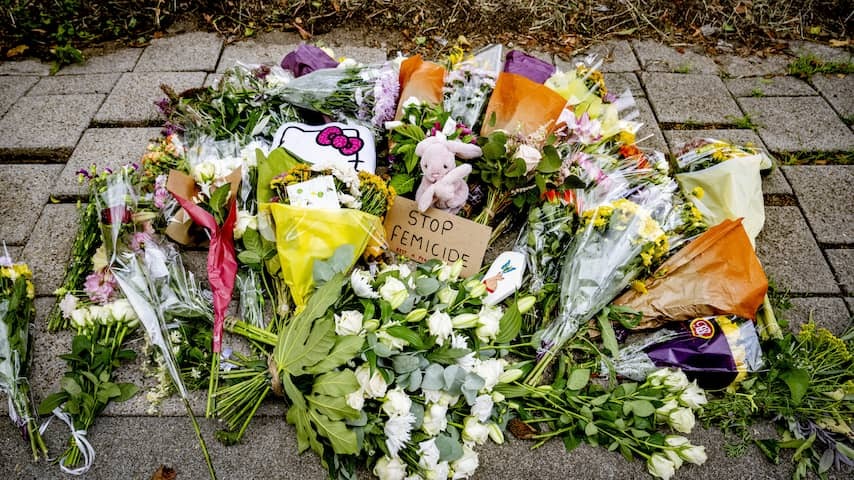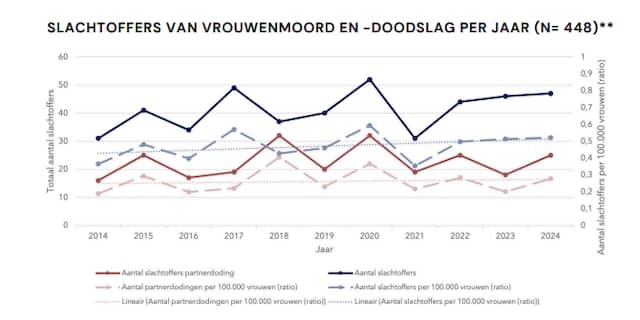
The 39-year-old woman who was shot dead in Gouda on Tuesday had reportedly been hiding in a shelter for battered women out of fear of her ex-partner. Because he is possibly the perpetrator, the word femicide is appearing in various media. But what does that actually mean?
“Femicide is actually the murder of a woman because she is a woman,” Saskia Belleman tells NU.nl. The Telegraaf journalist has dedicated a podcast series to the topic. “The problem is that it’s actually a container term,” she adds immediately. Marieke Liem, professor of Security and Interventions at Leiden University, confirms that there is no clear definition.
Some people only call a murder femicide if it involves (ex-)partner killings preceded by signals such as domestic violence. Others include family killings, such as a father who murders his daughter. A broader definition also includes murders of sex workers.
Liem is working on the Femicide Monitor (with all murders of women). She summarizes the problem with the term femicide in one sentence: “How do we know if a woman is killed because she is a woman?”
Therefore, the researchers working on the monitor speak of female murder. That makes it clear: “We always know if a murder has been committed, because then the victim is dead and we know when it is a woman.”
All murders of women are investigated, including the one in Gouda
For the Femicide Monitor, Liem investigates all murders of women from 2014 to the present. She looks at whether there were prior signals and whether there was contact with aid workers. She also looks at the relationship between the perpetrator and the victim. “We include all murders of women in that.”
The case in Gouda will therefore also be investigated by Liem. “As one of the 35 to 40 cases that take place annually.” In the graph below you can see the numbers.

Liem thinks it is too early to say whether there was femicide in Gouda. Belleman does. “That seems clear to me,” says the journalist.
For example, Belleman points to social media messages presumably written by the man. In it, he asks for information about the woman’s whereabouts. He says he suspects that his ex-partner is in a shelter for battered women with their children. That is a safe and anonymous location where someone who has experienced (serious) domestic violence or threats can go into hiding. His Facebook messages show that the man was furious with the woman because he had not seen his children for weeks.
“It has all the appearance of being a femicide case,” says a spokesperson for the Public Prosecution Service (OM) of Oost-Brabant. The woman and the suspect both come from Eindhoven.
The OM Oost-Brabant previously confirmed to NU.nl that the woman filed a report against her ex-partner on June 2. He was then arrested for possession of weapons and abuse of his ex-partner. He was brought before the examining magistrate on June 5 and then held for two weeks for possession of weapons.
‘How many signals do you need?’
“What possessed the police not to take action on this?”, says Belleman in response to the messages on social media. “How many signals do you need?” According to her, it is a pattern that comes back “every now and then”. According to her, women are taken much less seriously by the police than men. “Oh madam, have a glass of wine,” women would hear. Belleman: “Such a woman is not taken seriously until it is too late.”
Liem is milder towards the police. “The police, the Public Prosecution Service and aid workers are running their hearts out, but they cannot do it alone.” At the same time, she also recognizes stories of women who are not taken seriously by the police. “That is the worst thing that can happen.” Emotion resonates in her voice as she continues: “That goes through marrow and bone.”
“The police receive a report about domestic violence every five minutes,” Liem knows. And before people report it, they have experienced it an average of 33 times. “That is gigantic and that is just the average.” That is why Liem hopes that women will talk earlier, for example with the family doctor or family members. “You are not alone,” she emphasizes.
Liem gives an example of what many people think femicide is. That corresponds to the case in Gouda: man stalks woman, woman comes to a shelter for battered women, man shoots woman dead. To put femicide so simply can be dangerous, according to her. “There are many other forms,” she emphasizes. Signals of this can then be missed. Such as a man who gets into financial trouble, has suicidal thoughts or a perpetrator and victim who are seriously addicted. The threat to do something to a pet can also be a signal.
Belleman, Liem and the spokesperson for the Public Prosecution Service all agree that it is important to name murders of women as such. It doesn’t matter much to Belleman what word we use for it. “It’s about recognizing it as a problem and doing something about it.”